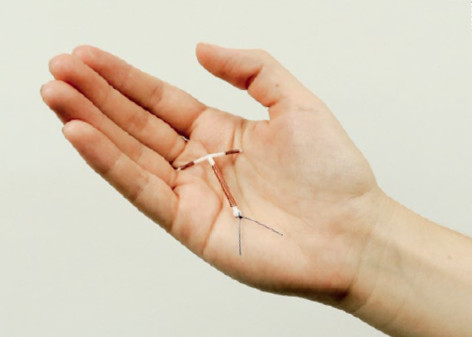Copper IUD
What is the copper IUD?
A copper IUD is a small device with a fine copper wire wrapped around a plastic frame. It's placed inside the uterus to prevent pregnancy. A fine nylon thread is attached to the IUD - the thread comes out through the cervix into the top end of the vagina. There are two types of copper IUDs available in Australia - one lasts for 5 years and the other for 10 years.

How does the copper IUD work?
The IUD is placed inside your uterus by a doctor or nurse.
The copper IUD:
- is toxic to the egg and sperm which stops sperm from fertilising the egg
- slows the transport of the egg to delay chance of sperm and egg meeting
- changes the lining of the uterus to make it unable to support a fertilised egg
How well does the copper IUD work?
The copper IUD is 99.5% effective.
Who can use the copper IUD?
The copper IUD is an option for people who:
- want a reliable, long-term contraceptive
- haven't had a pregnancy, have completed their families, or are spacing their pregnancies
- are breastfeeding
- cannot, or do not want to, use hormonal contraception because of medical conditions or personal preference
You should not use the copper IUD if:
- you think you might be pregnant
- you have had a recent infection called pelvic inflammatory disease (PID)
- you have unusual bleeding from your vagina
- you have Wilson's disease or you are allergic to copper
It is important to talk to your doctor before deciding to use the copper IUD if:
- you have painful or heavy long-lasting periods
- you have anaemia (not enough iron in your blood)
- you have had a recent sexually transmissible infection (STI)
- you have fibroids or other conditions that change the shape of your uterus
- you have had problems in the past with an IUD (for instance it has come out by itself)
- you are unable to have a follow-up check-up after the IUD is put in
Advantages
- It's very effective
- It can stay in place for 5 or 10 years depending on which one you choose
- The initial cost of a copper IUD is more than for other methods, but it lasts for 5 or 10 years so it works out to be a reasonable price
- It does not contain hormones so it has no hormonal side-effects
- Your fertility goes back to normal straight away when you take it out
- It can be used as emergency contraception if it is put in up to 5 days after unprotected sex.
Disadvantages
- It doesn't protect against sexually transmissible infections (STIs)
- It requires a procedure to be put in and removed from the uterus; putting it in can be uncomfortable or painful for some people
- When the IUD is put in there is a small chance of:
- difficulty inserting the IUD
- damage to the wall of the uterus (perforation)
- infection
- It can sometimes come out by itself
- Your periods can be heavier and last longer
- You can have some irregular spot bleeding in the first few months
How do I get a copper IUD?
Only a specially trained doctor or nurse can put in an IUD. You may need to make two visits.
- the doctor or nurse will ask questions about your health
- you might have a vaginal examination, a cervical screening test or a test for infection
- putting the IUD in takes about 10 minutes - you will be at the clinic for about 1 hour
- you may find it uncomfortable or painful and some people can faint
- you can have a local anaesthetic
- some people have the IUD inserted under sedation - not all clinics provide this
After your copper IUD is put in:
- you may have cramps and bleeding or spotting in the first few days - you can take paracetamol or ibuprofen or use a heat pack. If cramps, spotting or pain last more than a few days, see your doctor
- avoid sex, tampons, swimming and baths for 2 days to reduce the risk of infection
- go back for a check-up if you have any concerns
- check the IUD threads each month after your period to make sure the IUD is still in the right place - your doctor or nurse will show you how to do this
Things to remember with your copper IUD:
- check the threads each month after your period to make sure the IUD is still in the right place
- if you have any unusual symptoms (discharge from your vagina, pain low in your tummy or deep pain during sex) see your doctor straight away
- if you are worried you could be pregnant, have a pregnancy test - this includes if your period is more than a week overdue or you have a change in your bleeding pattern
- if you or your partner have a new sexual partner, use a condom every time until you both have been checked for STIs
- keep a record of the date to take out your IUD - it shouldn't stay in for longer than the recommended time
How is the copper IUD taken out?
The copper IUD can stay in place for 5 or 10 years, depending on the type you choose. If you are aged 40 years or more when it is put in your doctor may advise you that it can be kept in place until menopause. If you want to get pregnant or you no longer want the IUD it can be taken out earlier. Your doctor or Family Planning NSW clinic can take it out. The doctor or nurse uses a special instrument to remove the IUD by pulling on the threads. It only takes a couple of minutes. Some people find it uncomfortable and some do not feel much at all. If you want another copper IUD, the old one can be taken out and the new one put in at the same time.
For more information
Family Planning NSW Talkline - www.fpnsw.org.au/talkline or 1300 658 886
National Relay Service (for deaf people) - 13 36 77
TIS National's interpreting service - 131 450
Visit your nearest Family Planning NSW clinic - www.fpnsw.org.au/clinics
Family Planning NSW client resource on contraception - What suits me?



